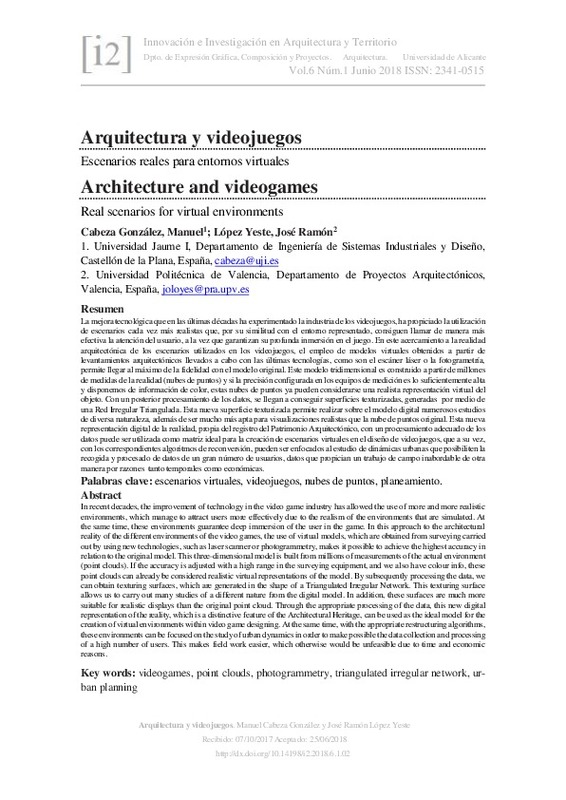|
Resumen:
|
[ES] El levantamiento arquitectónico llevado a cabo con nuevas tecnologías, como el escáner láser o la fotogrametría, permite la re-creación de un modelo virtual tridimensional del original, construido a partir de millones ...[+]
[ES] El levantamiento arquitectónico llevado a cabo con nuevas tecnologías, como el escáner láser o la fotogrametría, permite la re-creación de un modelo virtual tridimensional del original, construido a partir de millones de medidas de la realidad (nubes de puntos). Si la precisión configurada en los equipos de medición es lo suficientemente alta y disponemos de información de color, las nubes de puntos ya pueden considerarse una representación virtual realista del objeto. Con un posterior procesamiento de los datos se consiguen superficies texturizadas, generadas como una Red Irregular Triangulada. Esta superficie texturizada permite realizar al modelo digital numerosos estudios de diversa naturaleza, además de ser mucho más apta para visualizaciones realistas que la nube de puntos original. El objetivo de este trabajo es demostrar como esta nueva representación digital de la realidad, propia del registro del Patrimonio Arquitectónico, con un procesamiento adecuado de los datos, sirve como matriz ideal para la creación de escenarios urbanos virtuales en el diseño de videojuegos
[-]
[EN] In recent decades, the improvement of technology in the video game industry has allowed the use of more and more realistic
environments, which manage to attract users more effectively due to the realism of the ...[+]
[EN] In recent decades, the improvement of technology in the video game industry has allowed the use of more and more realistic
environments, which manage to attract users more effectively due to the realism of the environments that are simulated. At
the same time, these environments guarantee deep immersion of the user in the game. In this approach to the architectural
reality of the different environments of the video games, the use of virtual models, which are obtained from surveying carried
out by using new technologies, such as laser scanner or photogrammetry, makes it possible to achieve the highest accuracy in
relation to the original model. This three-dimensional model is built from millions of measurements of the actual environment
(point clouds). If the accuracy is adjusted with a high range in the surveying equipment, and we also have colour info, these
point clouds can already be considered realistic virtual representations of the model. By subsequently processing the data, we
can obtain texturing surfaces, which are generated in the shape of a Triangulated Irregular Network. This texturing surface
allows us to carry out many studies of a different nature from the digital model. In addition, these surfaces are much more
suitable for realistic displays than the original point cloud. Through the appropriate processing of the data, this new digital
representation of the reality, which is a distinctive feature of the Architectural Heritage, can be used as the ideal model for the
creation of virtual environments within video game designing. At the same time, with the appropriate restructuring algorithms,
these environments can be focused on the study of urban dynamics in order to make possible the data collection and processing
of a high number of users. This makes field work easier, which otherwise would be unfeasible due to time and economic
reasons.
[-]
|









